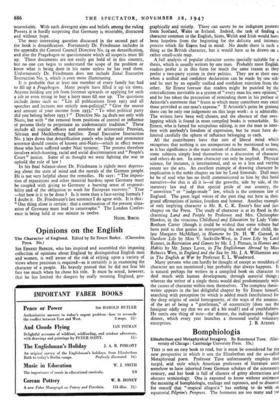Bomphiologia
THIS is not an easy book to read, but it must be considered for the new perspective in which it sets the Elizabethan and the so-called Metaphysical poets. Professor Tuve unfortunately employs that turgid, arid style which American professors of literature seem somehow to have inherited from German scholars of the nineteenth century, and her book is full of clusters of gritty abstractions and obscure terminology. One is expected to know without assistance the meaning of bomphiologia, enallage and tapinosis, and to discover for oneself that " tropical- allegoria " has nothing to do with an equatorial Pilgrim's Progress. The footnotes are too many and too
long, and frequently present the appearance of a page of logarithms ; and there are 442 pages of close print.
Yet I think Professor Tuve's detailed study of the imagery of such poets as Spenser, Daniel, Donne and King in relation to Elizabethan writing on poetics, rhetoric and Ramist logic is justi- fied by the sometimes surprising, always illuminating, conclusions at which she arrives. She brings ample evidence for her thesis that both Metaphysical and non-Metaphysical poets of the period roughly from 1550-1650 were composing their poems according to the detailed principles and tropes laid down in the handbooks of Puttenham, Webbe and others, following the generally herd Renaissance view that poetry, as a department of rhetoric, had as its prime object the convincing of its readers of those truths which composed the Elizabethan Weltanschauung. The poet of the period, as Professor Tuve puts it, was always the master of his poem but seldom its subject. But she is at pains to show that the principles were by no means as inflexible or dull as has often been assumed ; they were in fact the poetical equivalent of the musical harmony and counterpoint. Not until the time of Dryden did they become ossified into " the rules."
So on Professor Tuve's view Donne's famous compass image is rather an example of what Elizabethan (and other) writers call catachresis than what twentieth-century critics have variously seen as " conical images," or something ripe for the maw of the psycho- analyst. I cannot resist quoting her remark that it would be as relevant to list Donne's anatomy images under " medical " as to classify the American slang phrase " I put my John Hancock to it" under its user's interest in constitutional history.
But Professor Tuve is acute enough to notice that misreading of poets of the past has often been fruitful in inspiring poets of the present ; indeed genuine changes in taste are often due to motivated misreading. " Reading what the poet did not write," she says, " is entirely allowable as a way of enjoying'poems. It is only that find- ings resulting from this pursuit should not creep into our critical judgements of a poet's aims or a period's character. Such findings are a part of literary history—but of the history of the critic's period." One of Professor Tuve's minor successes is that she induced at least one of her readers to reopen the long and firmly closed pages of Gregory Smith's Elizabethan Critical Essays, containing the works of Peacham, Puttenham, Webbe and others—and not for reference only. I would, however, criticise her brilliant exegesis of these writers in one single respect. In her thesis of the importance of these works to the poets, she ignores the fact that their main functions were the defence of English as a medium of poetry against strong propaganda from the Latinists, and against the even more powerful Puritans who regarded poetry either as idle-hour products of " abbey lubbers " or the favourite pursuit of the immoral. Many of the philosophical and rhetorical classicisms in which these poetics abound were a defensive facade, meant to buttress the dignity of poetry in English, to cash in on the new authority of the classics for the purpose of silencing the many enemies of poetry. But this fact by no means negates Professor Tuve's reorientation of our views
of Elizabethan and Metaphysical imagery. KENNETH YOUNG.





























 Previous page
Previous page